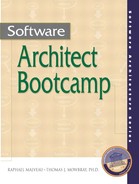Preface
Software architecture is an emerging discipline and an exciting career path for software professionals. We encourage both new and experienced practitioners to read this book as an aid to becoming better software architects. You may have noticed that most software books today do not say much about software architecture. Here, in this volume, we've concentrated the knowledge that you need to be the most effective architect possible.
As co-authors, we have lived through the experience of graduating from "member of technical staff" developers to becoming practicing software architects at the most senior levels of our respective companies. We are technical people, not managers, and we enjoy the technical nature of our work. We enjoy parity of salary and benefits with the senior managers at our respective firms. In other words, we are none-the-worse-for-wear as a consequence of choosing a software architecture career. We think that many of our readers would like to gain from our experience. Hence this book.
This is more than a book about software architecture. It is a field manual that can train you. We choose the pseudomilitary style, because it embodies an essential attitude. As a software architect, you need many survival skills— some technical, some political, some personal. While neither author has mili- tary experience, we have seen software architecture become a battleground in many ways. It is a battleground of ideas, as developers compete to forward their own concepts. It is a battleground for control of key design decisions that may be overruled by managers or developers, perhaps covertly. It is a battleground with many risks, since architects are responsible for a much wider range of technical and process risks than most managers or individual developers.
If you are a practicing software architect, we know that you are a busy professional. After buying this book, we would suggest that you peruse the table of contents and the index for topics that are new to you. Focus on those sections first. When you have time, we suggest that you attempt a cover-to-cover read-through, to familiarize yourself with all of the covered topics and terminology.
If you are new to architecture and want to become a software architect, we suggest that you do a cover-to-cover read-through beginning with the first chapter. Work the exercises provided, which will add an experiential learning element to your experience base.
Raphael Malveau
Thomas J. Mowbray, Ph.D.
McLean, Virginia, U.S.A.
Acknowledgments
We would like to express our thanks for all of the generous support of our friends and the technical contributions of our fellow software architects. In particular, we wish to recognize: Jan Putman, Kirstie Bellman, Liz Zeisler, Thad Scheer, Marc Sewell, Laura Sewell, Hernan Astudillo, Theresa Smith, Roger Hebden, Chip Schwartz, Jack and Gillian Hassall, John Eaton, Dr. Amjad Farooq, John Holmes, John Weiler, Kevin Tyson, Kendall White, Chibuike Nwaeze, Dave Dikel, David Kane, John Williams, Bhavani Thuraisingham, Jim Baldo, Eric Stein, John Hetrick, Dave Gregory, John Bentley, Nigel Pates, Richard Taylor-Carr, Dan Lam, Garrett Fuller, David Broudy, Mike Baba, Burt Ellis, Matthew Presley, Robert Davis, Peter Lee, Linda Kemby, Georgene Murray, Alfredo Aunon, Jim Gray, and Woody Lewis.
